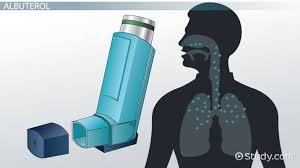Introduction
Asthma, chronic obstructive pulmonary disease (COPD), and other breathing disorders affect millions of people worldwide. One of the most trusted medications used for rapid relief of these conditions is salbutamol, also known as albuterol in some regions. Patients often refer to it as a “rescue inhaler” because it delivers quick relief during sudden attacks of breathlessness or wheezing. But many people, including patients and caregivers, wonder: how does salbutamol work inside the body? To answer this question, it is essential to understand the drug’s mechanism of action, its role in relaxing airway muscles, and its clinical relevance in respiratory medicine. This article provides a comprehensive explanation of how salbutamol works, covering its biological activity, pharmacokinetics, therapeutic uses, and safety considerations.
What Is Salbutamol?
Salbutamol is a short-acting β₂-adrenergic receptor agonist (SABA). That classification may sound complex, but it simply means that salbutamol selectively stimulates a specific type of receptor, known as the β₂ receptor, which is found primarily in the lungs. Unlike other medications that take hours to act, salbutamol produces noticeable improvement in breathing within minutes. It was first introduced in the late 1960s and has since become one of the most prescribed and widely used drugs for asthma and COPD management. Doctors rely on it because of its effectiveness, quick onset of action, and relatively low risk of side effects when used correctly.
Salbutamol Mechanism of Action
To fully understand how salbutamol works, we must take a closer look at what happens when the medication is inhaled into the lungs.
Binding to β₂ Receptors
When a person inhales salbutamol through a metered-dose inhaler or nebulizer, the drug particles travel directly into the bronchial passages. Here, salbutamol binds to β₂-adrenergic receptors located on the surface of the smooth muscle cells that line the airways. These receptors act like molecular “switches” that control how tight or relaxed the airway muscles are.
The Signal Cascade and cAMP
Once salbutamol binds to the β₂ receptor, it activates a protein called G-protein (Gs type), which in turn stimulates adenylate cyclase, an enzyme responsible for producing cyclic adenosine monophosphate (cAMP). This rise in cAMP levels is a key event. Elevated cAMP activates protein kinase A (PKA), which reduces the amount of calcium inside the muscle cells. Since calcium is required for muscle contraction, lowering calcium levels relaxes the airway muscles.
Muscle Relaxation and Bronchodilation
With decreased calcium levels, the bronchial smooth muscles relax. This process is called bronchodilation, which means the airways widen, allowing air to flow more freely in and out of the lungs. This is the core explanation of how salbutamol works—it transforms constricted, tight airways into relaxed, open passages that relieve symptoms like wheezing, chest tightness, and shortness of breath.
Additional Effects on Inflammation
Apart from muscle relaxation, salbutamol also helps reduce inflammation in subtle ways. Raising cAMP prevents the release of inflammatory chemicals from cells such as mast cells and eosinophils. This anti-inflammatory effect is not as strong as corticosteroids, but it still contributes to its usefulness in controlling acute asthma symptoms.
Step-by-Step: How Salbutamol Works in the Lungs
To simplify the above details, here is a step-by-step breakdown of how salbutamol works:
- Inhaled salbutamol enters the bronchial passages.
- It binds to β₂ receptors on airway smooth muscle.
- Activation of receptors triggers G-protein stimulation.
- Adenylate cyclase is activated, producing cAMP.
- Increased cAMP activates protein kinase A.
- Intracellular calcium levels fall, reducing contraction signals.
- Smooth muscle relaxes, causing bronchodilation.
- Airways widen, airflow improves, and breathing becomes easier.
This stepwise pathway highlights why salbutamol is so effective in emergencies—it acts rapidly at the cellular level to reverse airway constriction.
Onset of Action and Duration
One of the main reasons salbutamol is considered a first-choice rescue medication is its speed. After inhalation, patients usually notice improvement in breathing within 5 to 15 minutes. The drug reaches its peak effect at around 60 to 90 minutes, and the relief typically lasts between 3 and 6 hours. Because of this relatively short duration, salbutamol is used for immediate symptom relief rather than long-term control. Long-acting β₂ agonists (LABAs) are used in combination with other drugs for maintenance therapy, while salbutamol remains the “go-to” rescue option.
Pharmacokinetics of Salbutamol
The way salbutamol is absorbed, distributed, metabolized, and excreted also contributes to understanding how salbutamol works.
- Absorption: When inhaled, most of the medication acts locally in the lungs, with only a small portion entering the bloodstream. Oral forms of salbutamol exist but are less preferred due to systemic side effects.
- Distribution: Once absorbed, salbutamol has a large volume of distribution, meaning it spreads widely throughout body tissues.
- Metabolism: The liver processes salbutamol, converting it into inactive compounds.
- Excretion: The kidneys eliminate both the unchanged drug and its metabolites, with a half-life ranging from 3 to 6 hours.
This pharmacokinetic profile explains why salbutamol acts quickly and why it must be taken multiple times a day if needed.
Clinical Benefits of Salbutamol
The primary benefit of salbutamol is rapid bronchodilation. For asthma patients, this means quick relief during an attack, allowing them to breathe normally again. In COPD, salbutamol helps reduce episodes of breathlessness caused by airway obstruction. It is also prescribed for exercise-induced bronchospasm, where patients experience difficulty breathing after physical activity. Interestingly, salbutamol is also used off-label to treat hyperkalemia (high potassium levels) because it helps shift potassium into cells.
Side Effects and Safety Profile
Like all medications, salbutamol has potential side effects. The most common include tremors, nervousness, headache, and a rapid heartbeat. These occur because, at higher doses, salbutamol can also stimulate β₁ receptors in the heart. Rarely, patients may experience severe side effects like paradoxical bronchospasm, where the airways constrict instead of relax. Another concern is hypokalemia, as salbutamol can lower blood potassium levels. Despite these risks, when taken as directed, salbutamol is generally very safe and well-tolerated.
Salbutamol vs Other Bronchodilators
Salbutamol is not the only bronchodilator available, but it remains the most widely used because of its speed and effectiveness. Long-acting β₂ agonists (LABAs), such as salmeterol, provide longer relief but cannot replace salbutamol in emergencies. Anticholinergics and theophylline are also bronchodilators but work through different mechanisms and are usually reserved for specific cases. Compared with these alternatives, salbutamol is fast, effective, and easy to use, making it indispensable in respiratory care.
Clinical Guidelines and Recommendations
Medical guidelines emphasize that while salbutamol is critical for acute symptom relief, it should not be the sole treatment for asthma. The Global Initiative for Asthma (GINA) recommends combining salbutamol with inhaled corticosteroids (ICS) for long-term management. Overuse of salbutamol without controller therapy can mask worsening inflammation, increasing the risk of severe attacks. This is why doctors stress the importance of both rescue and preventive medication.
Key Takeaways
The question of how salbutamol works can be answered: it binds to β₂ receptors in the lungs, raises cAMP, lowers calcium, relaxes smooth muscles, and opens the airways. This rapid bronchodilation makes it a lifesaving medication for asthma and COPD patients worldwide. While its effects are temporary, salbutamol remains a cornerstone of emergency respiratory care. Understanding its mechanism not only empowers patients to use it correctly but also highlights its critical role in modern medicine.
Conclusion
Salbutamol is more than just a rescue inhaler—it is a finely designed drug that works at the molecular level to restore breathing when patients need it most. By targeting β₂ receptors, increasing cAMP, and relaxing airway muscles, it provides rapid and reliable relief from bronchospasm. Its pharmacokinetics explain its quick action and short duration, while its clinical benefits extend beyond asthma to include COPD, exercise-induced bronchospasm, and even hyperkalemia. Knowing how salbutamol works helps patients, caregivers, and healthcare professionals appreciate why it remains one of the most essential drugs in respiratory medicine
Do Read: Shift Select UPMC: Smarter Scheduling for Healthcare Professionals.





